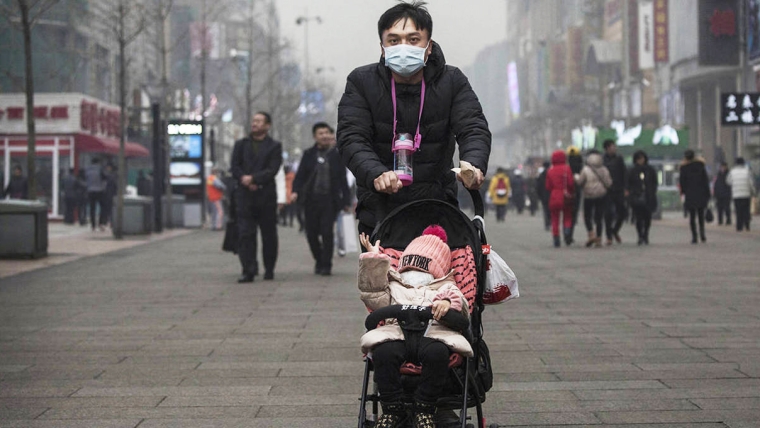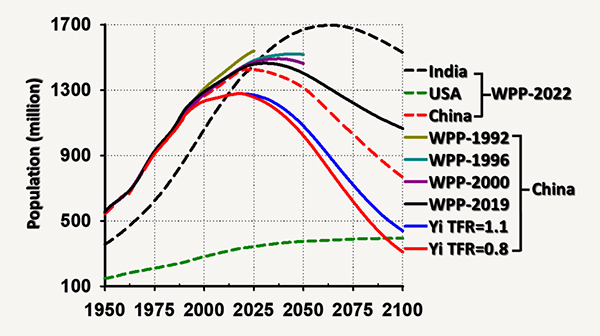
China’s population decline, which the Chinese government officially confirmed in January, has led many observers to wonder if the country’s current demographic trends threaten its stability.
According to the National Bureau of Statistics, China’s population shrank last year for the first time in 60 years, nine years earlier than government projections had anticipated. The fertility rate (births per woman) fell to 1.0-1.1, well below the official forecast of 1.8. Most notably, the number of births dropped sharply to 9.56 million, the fewest since 1790, despite China’s shift to a two-child policy in 2016.
But this sharp drop in the number of births is an illusion caused by a gross exaggeration of pre-2020 numbers. For example, a sample survey from 2016 showed a fertility rate of 1.25 and only 13 million births, which was later inflated to 18.83 million. Similarly, the United Nations’ World Population Prospects report, typically regarded as a reliable source for estimates and projections of Chinese demographic trends, is wrong every time, without exception. The 2022 WPP suggests that China’s population began to decline last year (ten years earlier than its 2019 projection), whereas I estimate that the decline began in 2018. The latest WPP also predicted that China’s population would fall to 767 million in 2100, far below its earlier forecast of 1.065 billion.
WPP projections still overestimate China’s population. While the 2022 WPP puts the Chinese population at 1.43 billion people, I estimate that it is now smaller than 1.28 billion. Moreover, according to the WPP, there were 28.2 million births in China in 1990 and 17.4 million in 2000. Yet the 1990 and 2000 censuses put the number of Chinese births at 23.7 million and 14.2 million, respectively, as confirmed by the number of ninth graders in 2004 and 2014.
The 2022 WPP also exaggerates China’s future population, predicting a fertility rate of 1.31 for 2023-50 and 1.45 for 2051-2100. The fertility rate among Chinese in the region suggests otherwise. Hong Kong, Macau, Taiwan, and Chinese Singaporeans have all had average fertility rates of 1.0-1.1 – the lowest in the world – over the past two decades, despite local authorities’ pro-natalist policies.
China’s efforts to boost its fertility rate face three major challenges. First, the one-child policy has reshaped the Chinese economy, dramatically increasing the cost of raising children. China’s household disposable income is equivalent to only 44% of its GDP, compared to 72% in the United States and 65% in the United Kingdom. The Chinese housing market was valued at four times the country’s GDP in 2020, whereas the American real-estate market is valued at 1.6 times GDP.
Chinese policymakers now face a dilemma: if the real-estate bubble does not burst, young couples will be unable to afford to raise two children. But if the bubble does burst, China’s economy will slow, and a global financial crisis will erupt. Likewise, raising household disposable income to 60-70% of GDP in order to increase fertility could reduce the government’s power, undermining the economic foundations of its current “authoritarian at home and aggressive abroad” policy approach.
Given these difficult tradeoffs, Chinese policymakers might be more inclined to replicate Japanese policies to lower child-rearing costs, such as reducing school fees and providing convenient childcare, childbirth subsidies, and housing benefits to young couples. But Japan’s approach has proved expensive and ineffective: the country’s fertility rate received a temporary boost, from 1.26 in 2005 to 1.45 in 2015, before falling back to 1.23 in 2022. Moreover, because it is “getting old before it gets rich,” China lacks the financial wherewithal to emulate Japan.
There are both physiological and cultural reasons for China’s demographic crisis. With more women delaying marriage and childbirth, the country’s infertility rate has increased from 2% in the early 1980s to 18% in 2020. From 2013 to 2021, the number of first marriages fell by more than half, and by three-quarters for 20-24-year-olds. And the one-child policy, which had been in place for 36 years, has irreversibly changed Chinese views of childbearing: having one child – or none – has become the social norm.
The more recent the cohort of Chinese women, the less willing to have children they seem to be. One recent survey found that while the average number of intended children among women in China is 1.64, the average decreases to 1.54 for women born after 1990 and 1.48 for women born after 2000. For comparison, in South Korea and Hong Kong, the average intended number of children is 1.92 and 1.41, respectively (both fertility rates are roughly half the intended figures). If this declining interest in childbearing is any indication, China will struggle to stabilise its fertility rate at 0.8, and its population will fall to less than 1.02 billion by 2050 and 310 million in 2100.
Ancient China also experienced population declines due to war and famine, but recovered quickly, similar to blood loss with normal regeneration. Modern population declines, like aplastic anemia, are hard to recover from.
Even if China succeeds in increasing its fertility rate to 1.1 and prevents it from declining, its population will likely fall to 1.08 billion by 2050 and 440 million by 2100. The country’s share of the world’s population, which declined from 37% in 1820 to 22% in 1950-80, will fall to 11% in 2050 and 4% by 2100.

The effects of this population decline will be compounded by rapid aging, which will slow Chinese growth and likely increase government debt. The share of Chinese people aged 65 and older will rise from 14% in 2020 to 35% in 2050. Whereas five workers aged 20-64 supported every senior citizen aged 65 and older in 2020, the ratio will continue to decline to 2.4 workers in 2035 and 1.6 in 2050. By that point, China’s pension crisis will develop into a humanitarian catastrophe. Women, who live 6-7 years longer than men, on average, and are usually a few years younger than their spouses, will ultimately pay the price for this painful demographic shift.
Yi Fuxian, a senior scientist in obstetrics and gynecology at the University of Wisconsin-Madison, is the author of Big Country with an Empty Nest. Copyright 2023 Project Syndicate, here with permission.
21 Comments
I've thought about how Total Fertility Rate (TFR) is calculated and whether the stats can be hiding a different story, maybe someone here knows a bit more about this. TFR is calculated as the sum total of all Age Specific Fertility Rates (ASFRs) at a point in time. So for a given year, we sum up all the births, group them by the age of the mother, and then divide through by the number of women in each age group. This gives us the average number of births for a women of every age group per year, and the TFR is the sum of all those births per age group giving us the total expected births per woman.
I think that calculated this way, this kind of statistic would mask a changing generational preference. Take for example a population of two women, aged 25 and 26. The woman aged 26 gives birth this year, and the woman aged 25 does not. The ASFR for 25 is 0, and the ASFR for 26 is 1. The TFR for this population is one. Next year, neither woman gives birth. Both ASFRs are 0, TFR is 0. This statistic shows that Total Fertility Rate is dropping over time. However, the woman who was 25 might have gone on to have her child at 28. Across an entire population, it is possible that we have a generational shift in a woman's age preference for birth. If that preference is later than previous generations, this shows up in the TFR as a decrease in fertility until those women go on to give birth later, at which point TFR goes up again.
Naturally there are the usual factors, increased education, access to contraception, women being free to choose to not have children and so on, and a greater preference for giving birth at a later age has it's own impact on fertility, but I wonder if the way this statistic is calculated hides something that will show up later.
China is screwed.
mind you, we all are. But don’t let China and their friends in the West convince you that they are the road to riches and will dominate the world. Because they aren’t, and they won’t.
Peter Zeihan has the best take on China and what plays out globally for the next 10 or so years.
Yes - he describes China's and Russia's demographics as terminal.
He also puts the US and NZ a slot above most western nations - our demographics are a bit shit, but not as bad as the pack.
It's not clear to me that population growth is necessarily a good thing and decline a bad thing if we measure "good" as rising GDP per capita or median disposable income or some other measure of lifestyle of the average person. Yes, any country with materially declining population will experience some for of economic contraction and there will be a temporary burden supporting the older people 'bulge' but if productivity improves and wealth is transferred, then that smaller population may well be better off. All else being equal, I bet Japan and China will actually be better places to live in 50-100 years time than now because they have smaller popualtions. India, Africa not so much.
Compare small families with large families.
Watch India.... going to be a regional power or a super power?
Not sure about that. People have been predicting their rise for a long time.
As much as I detest communism, I think it’s been key to China’s rise. And India is obviously not communist.
"As much as I detest communism, I think it’s been key to China’s rise."
I don't agree. In my opinion China's economic rise happened despite its communism, not because of it.
China's rise was due to their economic reforms about 30-40 years ago during which China implemented some of the ideas which are fundamental to capitalist, free market economies, i.e the need for "competition" for example, etc.
While Chinese economy was more aligned with "communist/socialist" ideas before that, most of China lived in poverty.
If anything Capitalism is what made China rich, not Communism/Socialism.
US companies fleeing high wage costs, unions and the EPA, followed by intellectual property theft is what made China rise. Without a sudden shot in the arm from the West they were going nowhere. But its a fleeting, hollow victory - their tech skills are not great and deglobalisation will slow down their IP theft.
I see China as a poor country, with a massive army useless except for crowd control, and a declining population that will soon give up on looking after the old because it will be too expensive.
I like it. India will be super power by 2050.
Aren't they handicapped by most of them speaking English. To succeed you need a strong sense of belonging otherwise your best will be attracted to other wealthier places and your poor will look for the places with the best welfare benefits.
They should adopt NZ’s solution to a housing bubble leading to a decline in fertility, and import vast numbers of people from China.
I live in a very Chinese are of Melbourne and a number of my colleagues are young Chinese.
I do wonder if this demographic “time bomb” is genuine, wether there will be a call to repatriate.
A bollocks article.
Shows what nonsense you get from siloed education.
The planet - sans draw-down long-term, can support less people that China alone houses now. Of course we're better heading for less, and the sooner the better.
Medicine is mostly the same as economics; energy and resource and ecology-blind.
To borrow a phrase from John Key, I see an orderly reduction of population as a good problem to have.
JK said That? I'm dumbfounded. Obviously he wasn't referring to NZ.
Its surprising how low GDP Per capita is for China ranked 79th at $16,842 per person - below Botswana, not sure why it was way lower than I expected
India ranked lower still at 122nd @7,166 per person
NZ ranked 32 $40,748
UK 26th $44,920
Australia 21
United States 13th @ $59,928
https://www.worldometers.info/gdp/gdp-per-capita/
In reality this is not a problem, it is a solution. How about an article delving into this
Seems all those industrial toxins are working their magic on fertility rates.
It is mostly choice, particularly choices made by women over their fertility.
Watch for some countries begin to withdraw the rights of women to control their own fertility, like the USA

We welcome your comments below. If you are not already registered, please register to comment
Remember we welcome robust, respectful and insightful debate. We don't welcome abusive or defamatory comments and will de-register those repeatedly making such comments. Our current comment policy is here.